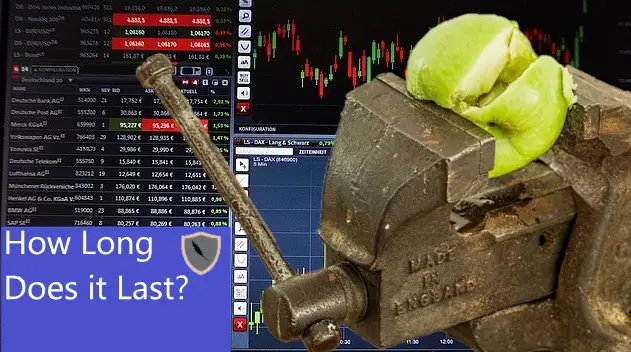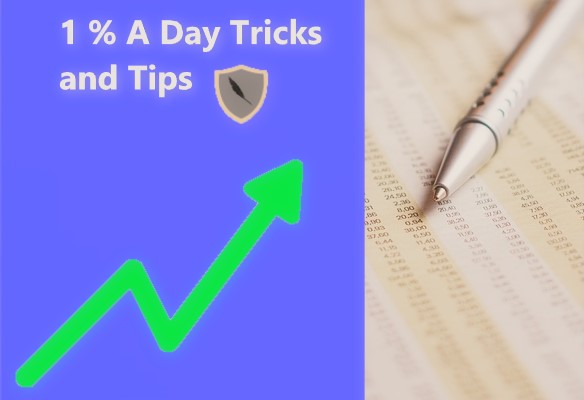The stock market is fluid in nature; Like a lung the market will expand and contract over time. These contractions can wreck your portfolio if you fail to hedge your overall investment. This article is going to show you the top 3 best ways to easily hedge your stock portfolio so that you can remain in the market and always make money.
The top 3 best ways to easily hedge your stock portfolio are the following.
- Invest in inverse positions
- Buy put option contracts
- Invest in Direct Inverse ETF’s
Hedging is an artform. If done properly your overall risk will be lowered and even negated. This will allow you to constantly generate wealth in the market. If you fail to hedge your portfolio however you will be constantly exposed to a stock market crash, which we do want.
Here at Chronohistoria I am all about helping others generate consistent returns in the stock market that are well above normal market returns (alpha). I constantly put out research articles and tips/tricks to better help you on your investing journey. If you feel up to it I have a newsletter, feel free to subscribe (top right of the screen).
Without wasting any time, let’s jump right into the top 3 best ways to easily hedge your stock portfolio.
What Is a Hedge?
The term hedging an investment comes from the ancient act of building a hedge around an estate to protect the property from the outside. The goal of ‘hedging’ in the stock market is to encircle your investment/portfolio with a protective barrier that will prevent you from losing your investment. (source for term ‘hedging’)
Simply put, we hedge an investment to protect the client from potential downfalls in their portfolio. A good portfolio manager will be able to spot a potential hedge and protect the client from any unforeseen pitfalls in their portfolio’s journey.
Normally you would have to pay a hefty premium for this kind of service. However, with the advent of the internet, and you finding this site, I am going to show you the top 3 best ways to easily hedge your stock portfolio.
Easy Hedge 1: Investing In an Inverse Position
An inverse position is the stock/equity/bond that gain in wealth should your primary investment begin to fail.
For example, if you were to invest in Pizza Hut in the United States and the next day Pizza Hut got hit by a meteor and declared bankruptcy. In this case the primary competitor to Pizza Hut, Domino’s Pizza, would increase in value. If you had invested in Dominoes at the same time as Pizza Hut then you would have lost less in the overall event.
Here is an image demonstrating how this inverse hedging works.
As we can see as the first investment begins to lose value the second investment gains in value. This will protect your overall portfolio and keep you in the market. This is the hardest of the 3 easiest ways to hedge because you will have to identify the inverse investment that will gain in price. For new investors I recommend simply inversing your investment with a currency hedge.
Example: The Currency Inverse Hedge
Ok, so this is a textbook example hedge. Here we are going to inverse an entire nation’s currency so that you will gain if inflation increases or a crazy event such as a pandemic hits.
For this example we are going to be looking at the U.S S&P 500 ETF, the SPY. We are going to be hedging against our investment in the SPY by investing in Gold, or the GLD ETF.
The reason why this inverse hedge works is because the U.S in 1971 decided to move their currency off the gold standard. President Nixon made this move because the U.S market was poised to become one of the largest in the world. The rest of the world was basing their currency off the gold standard and as such when the U.S dollar declines in value the price of gold goes up. (Source for 1971 decision)
For example here is a chart of the SPY and GLD to demonstrate this hedge. (Swipe left and right)


Notice how in 2020 during the pandemic the SPY declined in value by 32% while the price of GLD shot up by 28%. If you hedged your investment with the inverse currency hedge you would have been protected and even made more money. This is because the SPY eventually recovered in price while the price of GLD stayed near the same.
As we can see from the above chart in the long run this type of hedging methodology overall will increase the value of your portfolio while lowering your risk. Normally you would have to pay an asset manager to engage in this type of hedging but here at Chronohistoria I am showing you how to do it for free.
Easy Hedge 2: Buy Put Options Contracts
Buying put contracts on your investment is a great way to hedge against your downside and perhaps even make more money in the long run but it comes with a larger risk profile than the inverse hedge position strategy.
However, it is the only way to directly hedge your investment. That means that as your main position declines in value you will get a direct translation to your hedge’s value. This however comes with a downside, and that is the price of the option contract and time decay on the contract.
Buying an option put contract will cost you directly and over time the price of this contract will decrease in value. This means that your hedge investment over time is dissipating until it vanishes from your portfolio. Because of this your option put contract is a liability to your portfolio and not an asset. (Source for Finance ‘greeks’)
So why would anyone perform this investment strategy? The answer is because you guarantee both your downside and have a dedicated buyer for your investments. Due to this your investment is always protected no matter what happens. Sometimes it’s the only way to directly hedge.
Example of Put Options Contract Hedge
Every put option contract you buy guarantees your downside for 100 shares by securing a buyer at that price over the lifetime of the contract. For example let’s say you buy 100 shares of a stock at $100 and then buy a put option contract for $90 that expires in 2 years. Over the next 2 years then your maximum loss on that position is only $10 per share or 10% no matter what happens.
Here is a graph demonstrating this total risk profile.
In this scenario you bought 100 shares of a random stock at $100 per share for a total investment of $10,000. Right after you also bought 1 optio put contract at the $90 strike price good for 12 months.
Over the next 12 months the price of your shares went from $100 down to $45 per share. Normally this would result in a net loss of 55% on your total investment or $5,500 down the drain. However because you bought an option put contract you have guaranteed a buyer for your shares at the $90 strike price for the lifetime of the contract.
Therefore your maximum loss on the position is only 10% ($1,000) instead of the realized 55% ($5,500). This is the power of the option put contract.
Easy Hedge 3: Invest In Direct Inverse ETF’s
Ahh, the inverse ETF strategy. This is by far the easiest strategy but is also time sensitive. You can’t simply invest in an inverse ETF and wait, this is because they short the underlying asset and have to rebalance their position every day.
Don’t worry if that warning went over your head. Just remember to never leave your investment in an inverse ETF. You get in and out as fast as possible, preferably in under a day.
However if you can time the drop in your initial investment fast enough then chances are you can reap absolutely massive returns that far outstrip your initial investment. Let me show you an example.
Example of The Direct Inverse ETF
Let’s say you invested in the SPY in December of 2019. You heard rumors of a disease called Covid-19 breaking out in China but you thought that it was just a rumor. You bought 100 shares of SPY for a grand total of $31,500. Two months later in February of 2021 the U.S announced quarantine and your investment plummeted 30% in a week. Fortunately for you however you invested in the inverse ETF SQQQ right when this happened and saw a 100% increase.
(left image is the SPY, right is SQQQ)


SQQQ simply shorts, or bets that the underlying asset is going to go down in price. If you invest in SQQQ then you are betting that the U.S market will go down. If you time it right you will make a huge return.
This is the easiest way to hedge but requires you to constantly watch your portfolio for investment opportunities. If you leave your investment in SQQQ wait it will be rebalanced until it is worthless.
I WILL REPEAT, NEVER LEAVE YOUR INVESTMENT IN AN INVERSE ETF AS IT WILL DISSIPATE INTO NOTHING.
If you do this will happen. Here is SQQQ over the past 3 years.
Notice how over time the inverse ETF becomes almost worthless? This is because the ETF rebalances itself and its short position. It’s all about timing the downturn in your portfolio. If done properly then you will see gains in 20-60% nearly overnight.
Conclusions
There you have it, the top 3 best ways to easily hedge your stock portfolio. By picking and following one of the above strategies you will guarantee your downside while also limiting your total risk present in your portfolio. Now you can obtain the coveted ‘risk adjusted returns’ that wealth managers advertise to potential clients.
These are just the three easiest ways to easily hedge your portfolio. There are much more sophisticated methods that normally are not open to individual investors. Hedge strategies such as arbitrage trading, private equity, futures, etc. However, for 99% of the investors on the market these strategies will suffice.
As always if you like content like this then feel free to subscribe to the free newsletter. I am all about helping people generate consistent wealth in the market at rates that far outstrip normal market returns.
Further, you can check out some of the other articles below.
-
How Long Does a Short Squeeze Last? (3 Answers)

What is the time frame for you short squeeze? Well here is everything you will ever need to know to determine how long it will last.
-
Why You Still Own a Stock After It’s Delisted and How to Sell It

Do you still own a stock after its delisted? How do you sell it? Don’t worry the stock is still worth money and here is how to sell.
-
Can You Make 1% A Day in the Stock Market? (3 Steps)

Making 1% a day in the stock market is hard but defiantly doable. Here are 3 simple steps to helping you achieve this return.
Until we meet again, I wish you the best of luck in your investment journey.
Sincerely,


